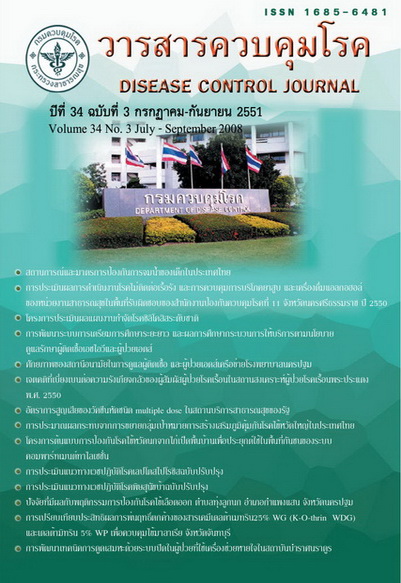Evaluation of National Silicosis Elimination Program
Keywords:
Evaluation of Silicosis, ThailandAbstract
The project "An Evaluation of the National Silicosis Elimination Program" had objectives to evaluate the implementation of the National Silicosis Elimination Program (or the National Silicosis Prevention and Control Program) and to improve the future plan. The National Silicosis Prevention and Control Program was evaluated by application of questionnaires, in depth interview, annual report data, silicosis situation report. From the data analysis on the structure, role and functions of the Provincial Public Health Office, it was revealed that after the re-engineering of government administration system in 2003 there was obviously change in the structure of the Provincial Public Health Office and only one officer in Occupational and Environmental Diseases work. The roles were monitoring, follow up and support public health organizations of district and sub-district level. The structure of the hospitals were not changed.For the medical doctors training on reading radiographs of pneumoconiosis according to ILO international classification. It was shown that 32.2% of hospitals had the trained medical doctors and only 14.5% of hospitals had system establishment (chest x-ray films were read by two medical doctors ; reader A and reader B) The factors on the policy of the executive administrator, proficiency of the personnels, equipments, budget, and team work affected the implementation of the National Silicosis Prevention and Control Program. According to the implementation analysis, it was reported that the trend of each target activity achievement decreased in each year ( 2002, 2003, 2006) which silicosis surveillance was implemented.
References
2. Substance profile: silica, crystalline (respirable size). Report on Carcinogen, eleventh edition.
3. Igor A. Fedotov, Global Elimination of Silicosis. Asian-Pacific Newlett on Occup Health and Safety. 1997; 4: 34-35
4. Chaiaroon Teeradej, Evaluation Research, 2003. Faculty of Social and Human Science, Mahidol University
5. Gregory R.Wagner, Screening and surveillance of workers exposed to mineral dust, WHO Geneva,1996 ; p3-4, p13-14.
6. ILO. Occupational safety and Health Series no.22: Guidelines for the use of ILO International Classification of Radiographs of Pneumoconioses. International Labour Organization, Geneva, revised edition. 1980, p4-5
7. รายงานประจำปีงบประมาณ 2544 กองอาชีวอนามัย กรมอนามัย กระทรวงสาธารณสุข หน้า 51
8. รายงานประจำปีงบประมาณ 2545 กองอาชีวอนามัย กรมอนามัย กระทรวงสาธารณสุข หน้า 58
Downloads
Published
How to Cite
Issue
Section
License
Articles published in the Disease Control Journal are considered as academic work, research or analysis of the personal opinion of the authors, not the opinion of the Thailand Department of Disease Control or editorial team. The authors must be responsible for their articles.



.png)



